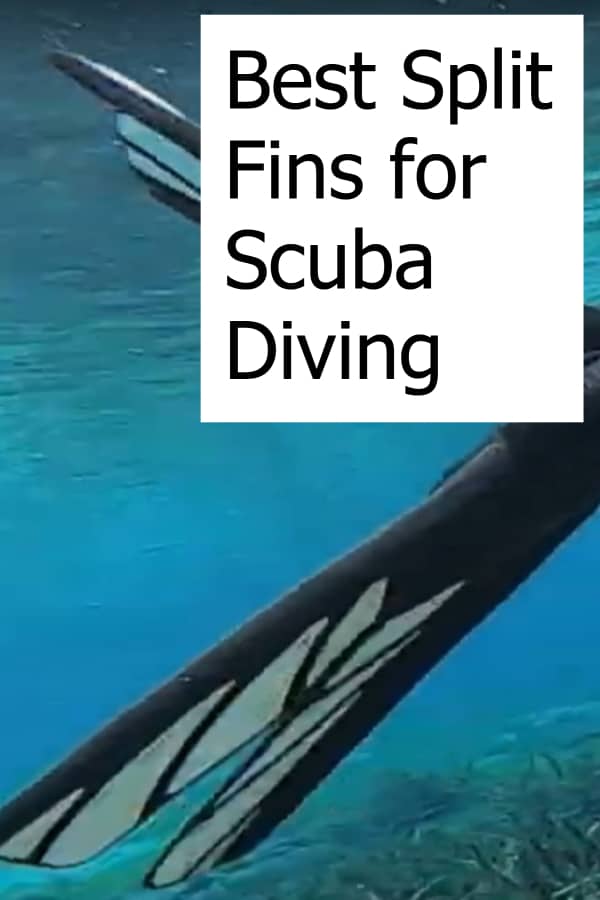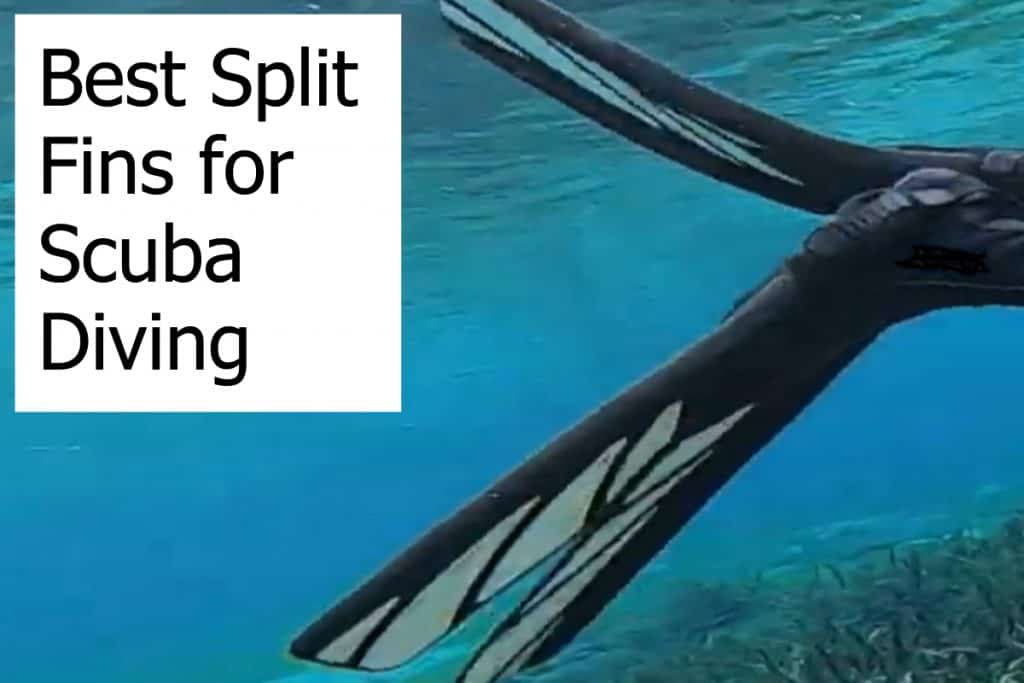Best Split Fins for Scuba Diving – Reviews and Buyers’ Guide
Scuba fins come in all sizes, stiffness, colors, and designs. This is to increase customer preference and experience. One such design element is that you can come across split fins.
Are they a good choice for diving? Are split fins better than traditional paddle fins? What makes split fins better? Let’s find out!
Not too long ago, a new design was introduced to the mix. That new design is none other than the split fin, which is, in theory, up to 30% more efficient than traditional paddle fins.
Though divers are still reluctant to try something new, they will find that the risk was worth the try for many reasons, such as split fins easier on the knees and ankles.
The Best Split Fins for Scuba Diving
We looked at the available split fins and chose the following five models for this review. They are, in our opinion, the best split fins on the market:
- Atomic Aquatics Full Foot
- Scubapro Twin Jet Max
- Atomic Aquatics Open Heel Split Fins
- TUSA SF-15 X-Pert Zoom Z3 Open Heel
- Oceanic Vortex V-16 (no longer produced)
Let’s dive a little deeper into each of these models to see their strengths and weaknesses.
Reviews of the Best Split Fins
You’ll find detailed reviews of each of the models we picked as the best split fins for scuba divers.
Atomic Aquatics Full Foot
Atomic Aquatics is known for pushing the boundaries concerning scuba gear. The split fins are a great example of that.
When split fins were introduced in the early 2000s, they quickly became seen as a gimmick and fad. Atomic Aquatics stuck with the design, learned from early issues with split fins, and finally mastered it.
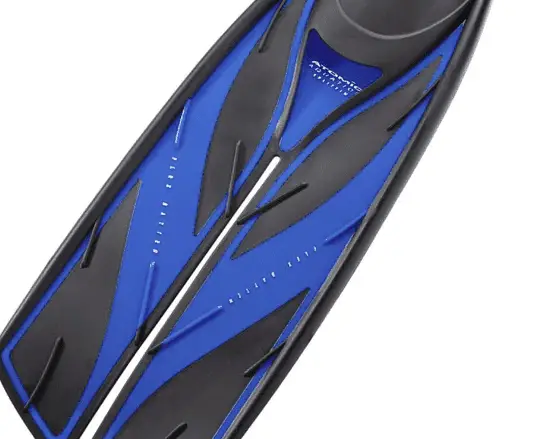
The Atomic Aquatics Full Foot Split fins are a great example of that. Once you master the usage of split fins, you will find that you get quite a bit more thrust with every kick compared to a paddle fin. You’ll get the hang of it pretty quickly.
You need to take extra care to size them correctly as full-foot fins don’t have a strap to adjust their fit. Typically, you won’t wear them with booties, and therefore, they are best used in warm water. If you pick the right size, then you’ll find that the foot pocket fits like a glove.
Another great feature of the Atomic Aquatics split fin is that it’s pretty light. It makes it an excellent choice for traveling. The downside is that they are less wide than many other flippers, and you’ll move less water resulting in less propulsion than wider fins.
Atomic Aquatics is usually not known for affordable scuba gear. The full-foot split fins from Atomic Aquatics are the exception, though. They are quite reasonably priced and worth a second look!
You can find them in a variety of colors online and at local dive shops. You’ll find the sizes corresponding to your foot size in available size charts. Keep in mind that you do not have to add space for dive boots with these full-foot split fins!
Pros
- Intelligent design and excellent materials used
- Full-foot pocket fits very well and is comfortable
- Excellent propulsion for the energy put into the kicks
- Pretty low in weight which makes it suitable for traveling
Cons
- Full-foot fin which is less adjustable than an open-heel fin
- Slightly thinner than other fins resulting in less propulsion with each kick
Scubapro Twin Jet Max
Scubapro is one of the best-known brands in scuba diving and snorkeling. They produce excellent designed and high-quality equipment that lasts. The best example of that is the Scubapro Jet fins, a true classic that has been a favorite among divers for many years.
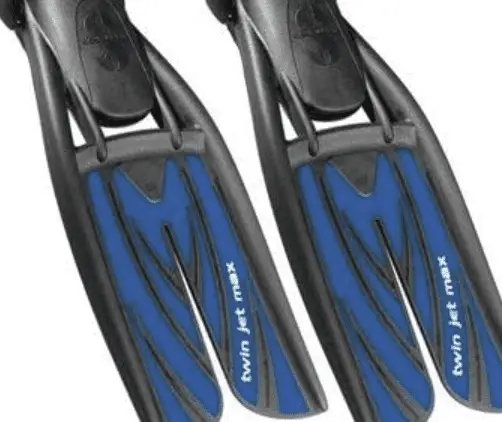
A successful and exciting evolution of those original Jet fins is the Scubapro Twin Jet Max. They are split fins that use slightly angled blades to increase the produced thrust for every kick. Scubapro patented that design, and it does provide more forward movement without you having to put in more effort.
Another unique feature are the vents right in front of the foot pocket. Scubapro added these to reduce the drag you experience when you kick up and down.
These fins are excellent examples of a good set of split fins. They are rugged and reasonably light. The stiffness is good, and you get an excellent translation of energy from your kick to propulsion in the water.
The Scubapro Twin Jet Max is available in several colors. The fins come in a single color compared to many other fins that have accent coloring. Sizing is easy and straightforward, and as they are open-heel fins, you do have to calculate the size, including your booties.
Pros
- Excellent design and materials used
- Built-to-last as you expect from Scubapro
Cons
- You do need booties with these open-heel fins
Atomic Aquatics Open Heel
Looking at the full-foot split fins from Atomic Aquatics, you might think you also get a good deal on these split fins. Unfortunately, that’s not the case. These are somewhat the Rolls Royce of split fins not only in design and performance but also in price.
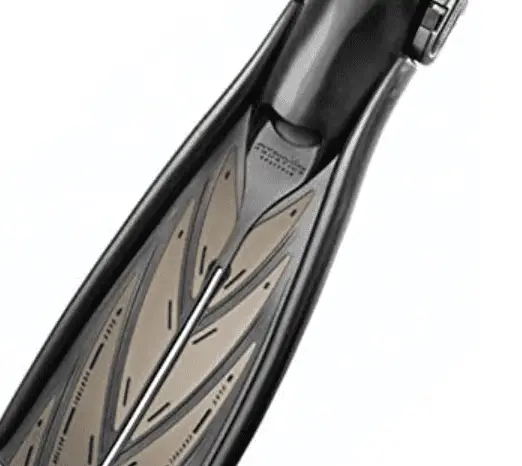
If you use the Atomic Aquatics Open-Heel split fins in the way they are designed to be used, you get outstanding performance. You can generate a lot of forwarding thrusts while not having to work as hard as with paddle fins or even other split fins.
The material mix used for these fins is proprietary. The fins provide stiff foot pockets and specifically designed rails on the outside of the fins to get the most energy from your kicks.
The fins are easily adjusted and are designed for single-handed use of the buckles to secure the fins around your heels quickly. There are several color choices available, and sizing is straightforward. Remember that you need dive boots when you decide on getting these fins!
Pros
- Excellent material mix resulting in an outstanding performance
- Comfortable foot pocket
- Secure straps for single-handed use
Cons
- Quite expensive
TUSA SF-15 X-Pert Zoom Z3 Open Heel
Tusa is a Japanese company that produces affordable yet high-quality scuba equipment. The TUSA SF-15 X-Pert Zoom Z3 split fins are no exception to that.
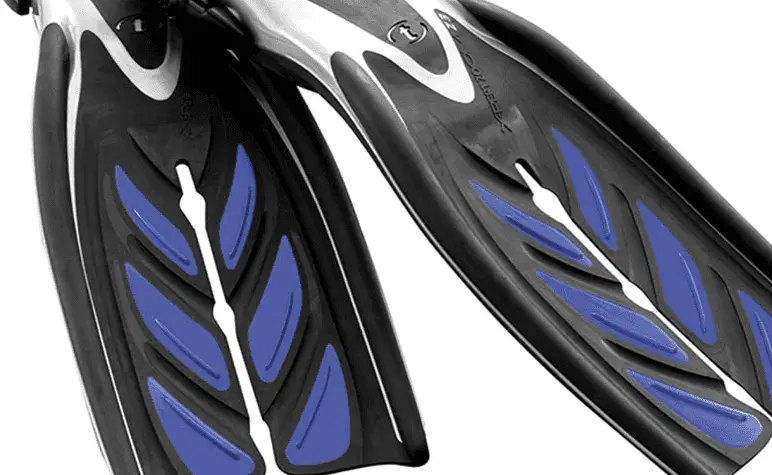
TUSA patented the blade design as they did create a unique design that significantly reduces the effort you need to propel yourself through the water. The blade(s) are specifically designed and composed to provide maximum thrust with a low amount of energy being put into the kick.
The downside to that great blade design is that the fins are a bit heavy. You’ll have to consider that when you take them with you when you travel.
You can get the TUSA SF-15 X-Pert Zoom Z3 in a variety of color choices to match your taste. Sizing of the fins is easy based on TUSA’s size charts that you can find online or in local shops that carry the brand.
Pros
- Unique and very efficient blade design
- Open-heel fin with easily adjusted straps
- Comfortable foot pocket design that works well with booties
Cons
- A little heavy and not a good choice for traveling
- Open-heel fins do pretty much prevent you from diving without dive boots
Oceanic Vortex V-16
The Oceanic Vortex V-16 is an excellent split fin. It’s an open-heel design and easily adjusts to your foot.
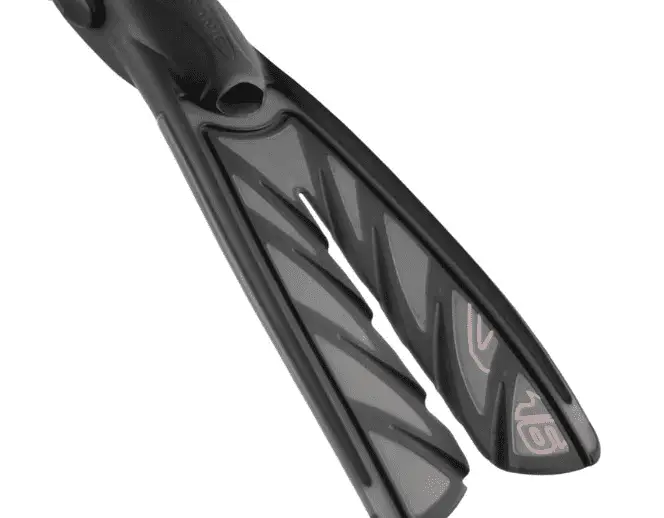
The fins are comfortable to wear and use. You get a good level of performance out of them for the energy you put into them.
The fin design was cleverly made, so you had stiff channels on the outside to provide rigidity. The split allowed the inside part of the fins to act in a fashion like a propeller, which produces a lot of propulsion to get you going.
Unfortunately, Oceanic no longer offers the Vortex V-16 split fins. However, you can often still find them online or at your local dive shop. If you get them at a reasonable price, then don’t hesitate to get a great deal for some sophisticated split fins!
Pros
- Excellent blade design with a mix of materials to produce a propeller effect for more propulsion
- Comfortable foot pocket with quick release straps for adjustment
Cons
- No longer produced and only available stocked items available for purchase.
Buyers’ Guide to finding the Best Split Fins
Even split fins come in different varieties. They are manufactured by different brands and will generally have different characteristics, which means varying performance.
Picking the right split fin requires thorough market research. To save you the trouble, here is a Buyers’ Guide that will tell you all you need to know before choosing split fins for scuba diving.
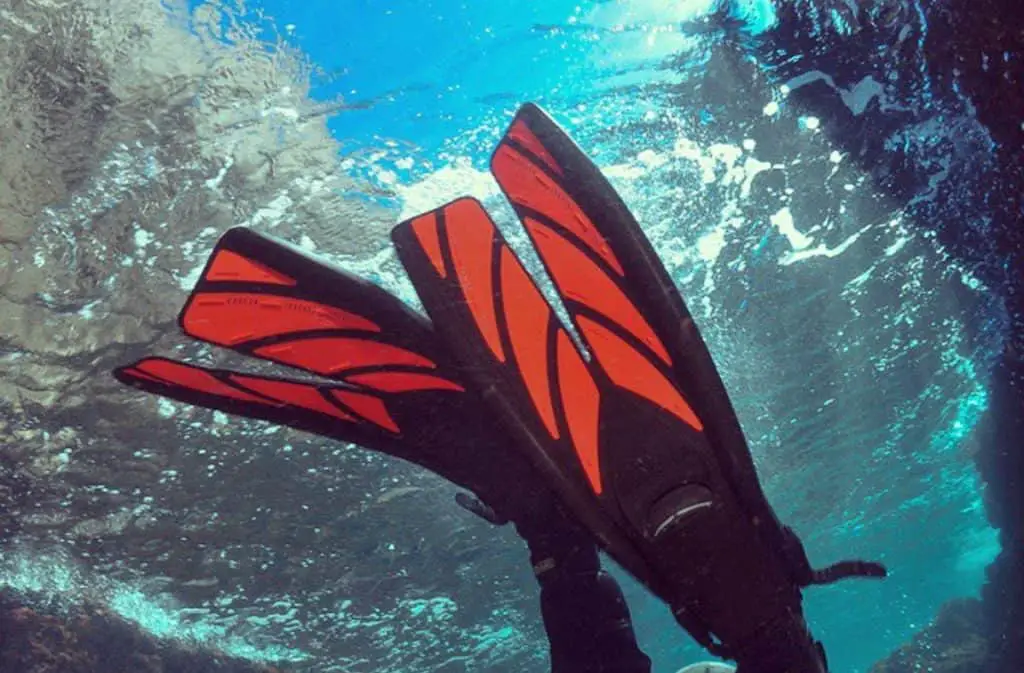
Differences between Paddle and Split Fins
But first, what is the difference between Split Fins and Paddle Fins?
When scuba diving began, divers used paddle fins, which resemble a boat paddle in shape, as the name suggests. However, split fins are a recent improvement of the previous model, though they have conquered the industry thanks to their efficiency. Paddle fins, having existed for quite a while, have dominated the sector hence are cheaper than their counterpart.
Designwise, paddle fins are more proven, so to say. They are also stiffer and more rigid, which makes them easy to use and provides a steady kick. On the other hand, split fins have a split design toward the end of the paddle, which makes them less rigid. The result of this is reduced kicking effort, yet they will give as much thrust force as the paddle fins.
This makes the split fins superior to the traditional paddle fins since they are easier to use, even when sustaining a knee or ankle injury. It could also mean that you get to stay longer in the water since air consumption is reduced.
On the flip side, however, note that the split fins are not appropriate for heavy and strong currents since this makes them harder to use. Use them in calm waters.
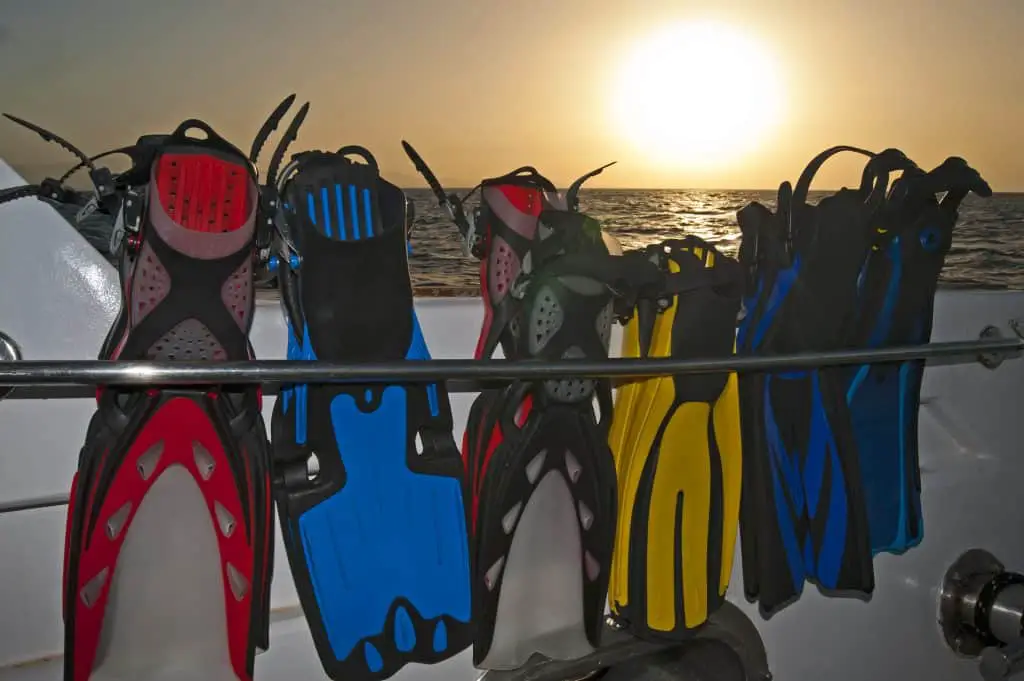
Blade Design
The blade of the split fin looks like the tail of a dolphin or whale, i.e., it is split into two at the tail. While you may be tempted to think that the design is less effective, the saying that looks can be deceiving couldn’t be more accurate.
The fin’s blade, being different from the paddle, reduces the effort required for forwarding propulsion because of space in between. This allows flexibility, which reduces drag. To minimize the drag even further, choose a pair that offers vents.
Theory of Split Fins
A split fin works behind the theory of action and reaction. When the driver kicks his feet downward, the water that passes through the split acts like a spring and propels him further.
A small kick is, therefore, able to produce enough thrust, which reduces potential diver exhaustion. This makes the split fins an ultimate choice for divers with knee issues, or ‘lazy’ ones, who like working smart over working hard.
Note that there is a specific method of kicking when using split fins. This is a flutter or straight action, instead of the frog kick, which won’t yield as much power as the two former kicking methods.
This way, you propel yourself easily. If you were taught scuba diving using the frog method and want to try the split fins, it may be time for you to learn something new!
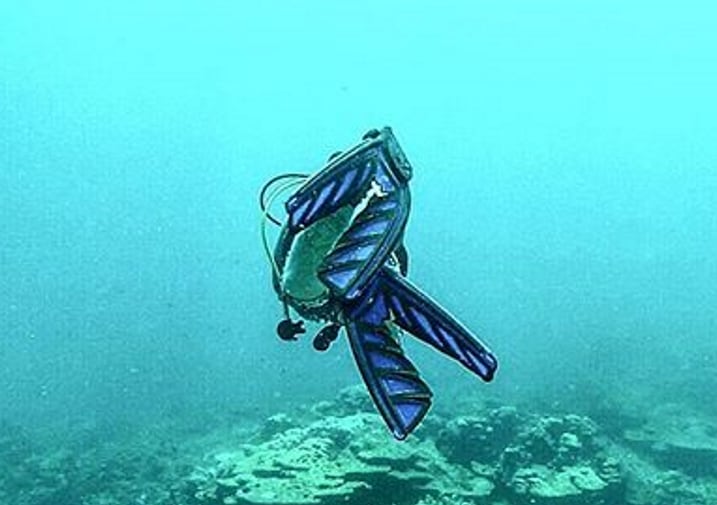
The working mechanism of Split Fins
Paddle fins’ working principle begins with kicking backward, which makes the water push you forward. Displaced water then spills on the sides.
The main problem with this is that the water spillage on the sides of the blades increases the amount of drag. This makes them a bit inefficient and, in some cases, quite unstable. The overall result is an increased effort in use.
On the other hand, split fins work like a propeller. As water moves through the split, it makes both sides curve, which makes a foil shape.
If you’ve heard of aerodynamics, you know that the best form to move in a fluid is the foil shape, which explains the shape of a plane’s wings. The foil-shaped fin creates lift, which pushes you forward.
Since water is directed towards the split, side spillage is minimal, which in turn minimizes drag and makes it easier to use. That’s a simple working mechanism, but one that delivers results.
Choosing Dive Fins
Before visiting the store, what is the scene you’re looking to build? Do you often dive in calm or turbulent waters? Do you dive very deep into the water, which means that you require more time underwater? What kind of scuba boots do you own?
If the answer to these questions alludes to split fins, which means that you often dive in calm waters and prefer to spend more time underwater, choose this kind of fin for convenience.
Once you visit the store, try out a variety of fins before settling on a final decision. This is especially the case if you are new to the sport to find the pair that feels comfortable.
Fit the booties first to ensure that the fins you purchase are compatible with your boots since they go together. If you already own some booties, visit the store and check out their compatibility with your chosen fins.

Choosing the best Split Fins
After narrowing down to the split fins over the paddle fin, you face yet another tough decision of variety. It is essential to choose the right pair as this could potentially make or break your underwater excursions. There are various considerations to make when selecting Split Fins.
First is the wearing technique. A split fin can either be open-heel or full-foot fins. The former has a strap that goes around the heel after the foot slipped into the fin.
It has a quick-release closure and is easily adjusted even while in the water. The full-foot fins slip on like a shoe and don’t necessarily require a boot.
We, however, feel that it does not give sufficient support like its fellow counterpart, and additionally cannot be adjusted in water. If the foot pocket doesn’t fit your foot perfectly you’ll risk either slipping out or having the foot pocket be too tight. Nevertheless, your choice of style primarily depends on personal preference.
It would help if you also looked for vents in the design. These go a long way in reducing the drag of the scuba fins. It makes them more efficient, especially for long-distance diving, since they reduce the energy required for propulsion.
Final Thoughts
We think that the TUSA SF-15 X-Pert Zoom Scuba Fins are the best split fins available based on price to performance. These scuba fins come with advanced propeller-fin technology and a patented angle-blade design that doubles up on performance.
If money doesn’t matter then go for the Atomic Aquatics Open-Heel scuba diving fins. If money is a factor then check to find the Oceanic Vortex V-16 or the Atomic Aquatic full foot scuba diving fins.
This means reduced fatigue and effort for propulsion more than others. To top it off, they are sleek and modern!
